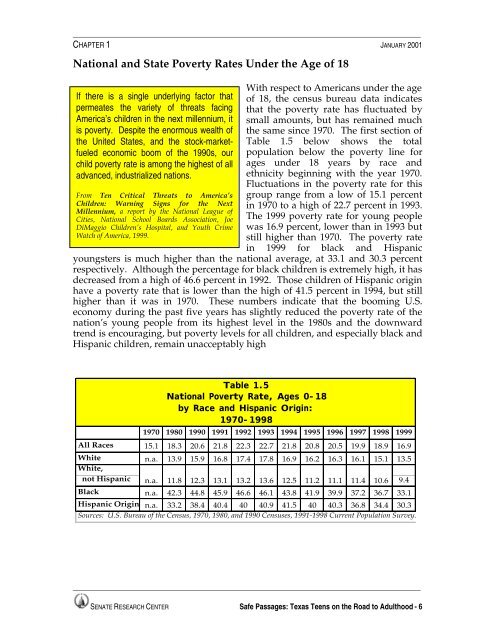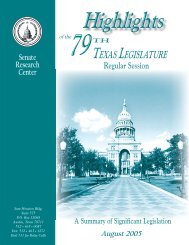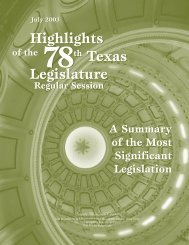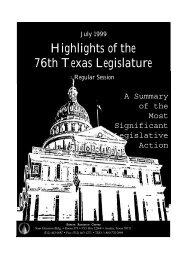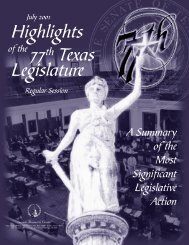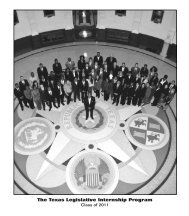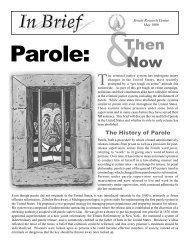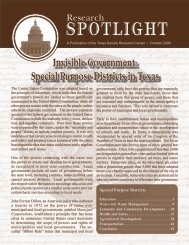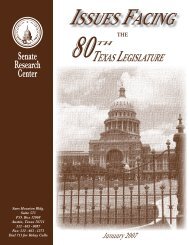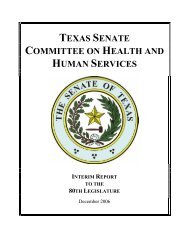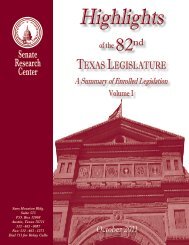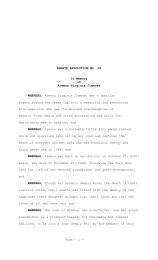Texas Teens Cover - Senate
Texas Teens Cover - Senate
Texas Teens Cover - Senate
You also want an ePaper? Increase the reach of your titles
YUMPU automatically turns print PDFs into web optimized ePapers that Google loves.
______________________________________________________________________________________<br />
CHAPTER 1 JANUARY 2001<br />
National and State Poverty Rates Under the Age of 18<br />
If there is a single underlying factor that<br />
permeates the variety of threats facing<br />
America’s children in the next millennium, it<br />
is poverty. Despite the enormous wealth of<br />
the United States, and the stock-marketfueled<br />
economic boom of the 1990s, our<br />
child poverty rate is among the highest of all<br />
advanced, industrialized nations.<br />
From Ten Critical Threats to America’s<br />
Children: Warning Signs for the Next<br />
Millennium, a report by the National League of<br />
Cities, National School Boards Association, Joe<br />
DiMaggio Children’s Hospital, and Youth Crime<br />
Watch of America, 1999.<br />
With respect to Americans under the age<br />
of 18, the census bureau data indicates<br />
that the poverty rate has fluctuated by<br />
small amounts, but has remained much<br />
the same since 1970. The first section of<br />
Table 1.5 below shows the total<br />
population below the poverty line for<br />
ages under 18 years by race and<br />
ethnicity beginning with the year 1970.<br />
Fluctuations in the poverty rate for this<br />
group range from a low of 15.1 percent<br />
in 1970 to a high of 22.7 percent in 1993.<br />
The 1999 poverty rate for young people<br />
was 16.9 percent, lower than in 1993 but<br />
still higher than 1970. The poverty rate<br />
in 1999 for black and Hispanic<br />
youngsters is much higher than the national average, at 33.1 and 30.3 percent<br />
respectively. Although the percentage for black children is extremely high, it has<br />
decreased from a high of 46.6 percent in 1992. Those children of Hispanic origin<br />
have a poverty rate that is lower than the high of 41.5 percent in 1994, but still<br />
higher than it was in 1970. These numbers indicate that the booming U.S.<br />
economy during the past five years has slightly reduced the poverty rate of the<br />
nation’s young people from its highest level in the 1980s and the downward<br />
trend is encouraging, but poverty levels for all children, and especially black and<br />
Hispanic children, remain unacceptably high<br />
Table 1.5<br />
National Poverty Rate, Ages 0-18<br />
by Race and Hispanic Origin:<br />
1970-1998<br />
1970 1980 1990 1991 1992 1993 1994 1995 1996 1997 1998 1999<br />
All Races 15.1 18.3 20.6 21.8 22.3 22.7 21.8 20.8 20.5 19.9 18.9 16.9<br />
White n.a. 13.9 15.9 16.8 17.4 17.8 16.9 16.2 16.3 16.1 15.1 13.5<br />
White,<br />
not Hispanic n.a. 11.8 12.3 13.1 13.2 13.6 12.5 11.2 11.1 11.4 10.6 9.4<br />
Black n.a. 42.3 44.8 45.9 46.6 46.1 43.8 41.9 39.9 37.2 36.7 33.1<br />
Hispanic Origin n.a. 33.2 38.4 40.4 40 40.9 41.5 40 40.3 36.8 34.4 30.3<br />
Sources: U.S. Bureau of the Census, 1970, 1980, and 1990 Censuses, 1991-1998 Current Population Survey.<br />
______________________________________________________________________________________<br />
SENATE RESEARCH CENTER Safe Passages: <strong>Texas</strong> <strong>Teens</strong> on the Road to Adulthood - 6


